Analysis of Business and Corporation Law for Assessment Task 2
VerifiedAdded on 2022/10/19
|11
|2607
|460
Report
AI Summary
This report, an assessment task for a business law course, provides a detailed overview of key legal concepts within the Australian context. It begins by outlining the structure of the Australian court system, differentiating between federal and state courts, and explaining the hierarchy and jurisdiction of each. The report then delves into tort law, contrasting it with criminal law and emphasizing the remedies available for injury claims. It discusses the concept of a 'reasonable person' in determining negligence, outlining exceptions such as children and individuals with disabilities. Furthermore, the assignment explores the nuances of negligence, including the elements required to establish a claim, such as duty of care, breach, harm, and causation. Finally, the report examines property law, differentiating between personal and real property and discussing the concept of fixtures, with reference to relevant case law. The report provides a comprehensive analysis of these legal principles, offering valuable insights into the application of business and corporation law in Australia.
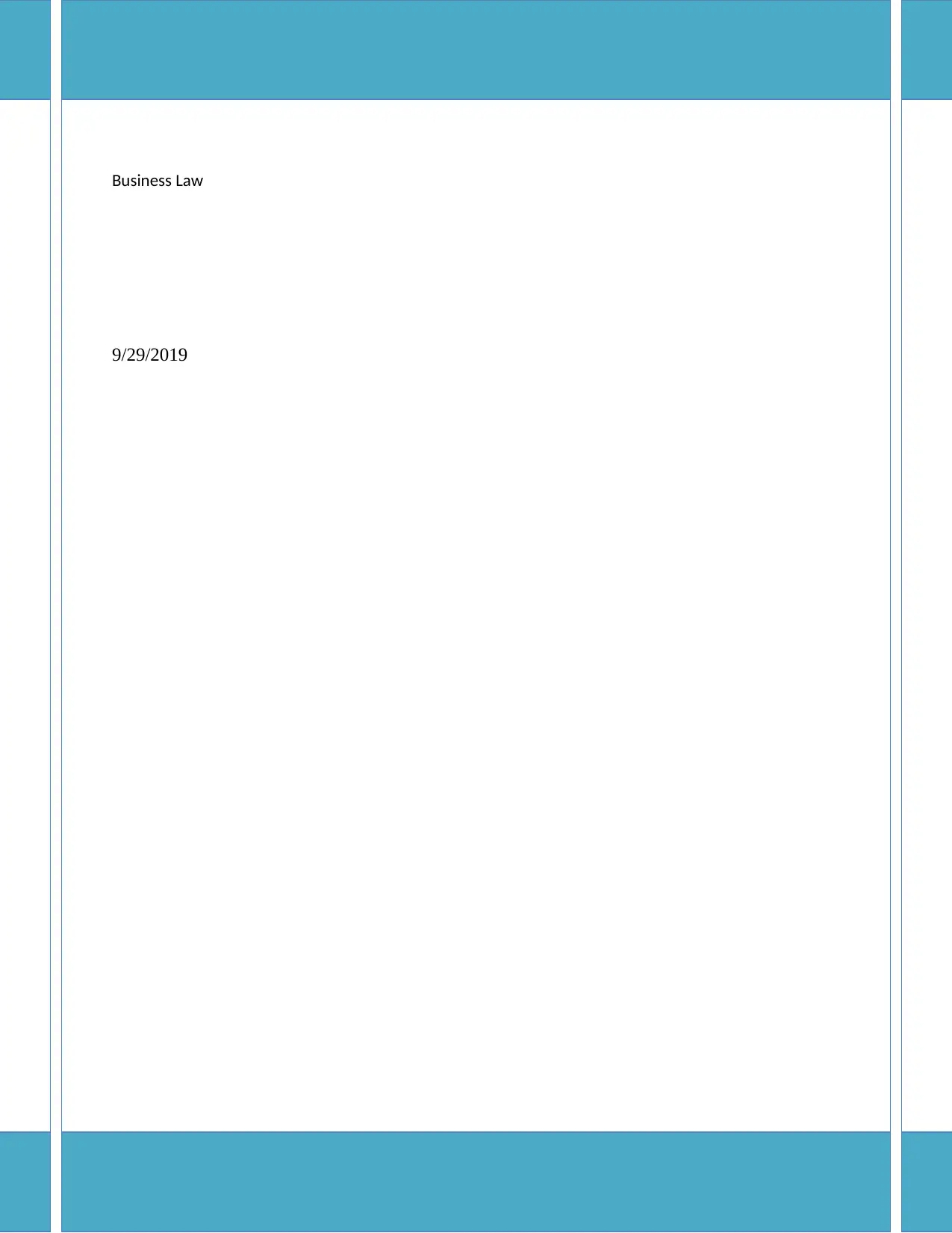
Running Head: BUSINESS AND CORPORATION LAW 0
Business Law
9/29/2019
Business Law
9/29/2019
Paraphrase This Document
Need a fresh take? Get an instant paraphrase of this document with our AI Paraphraser
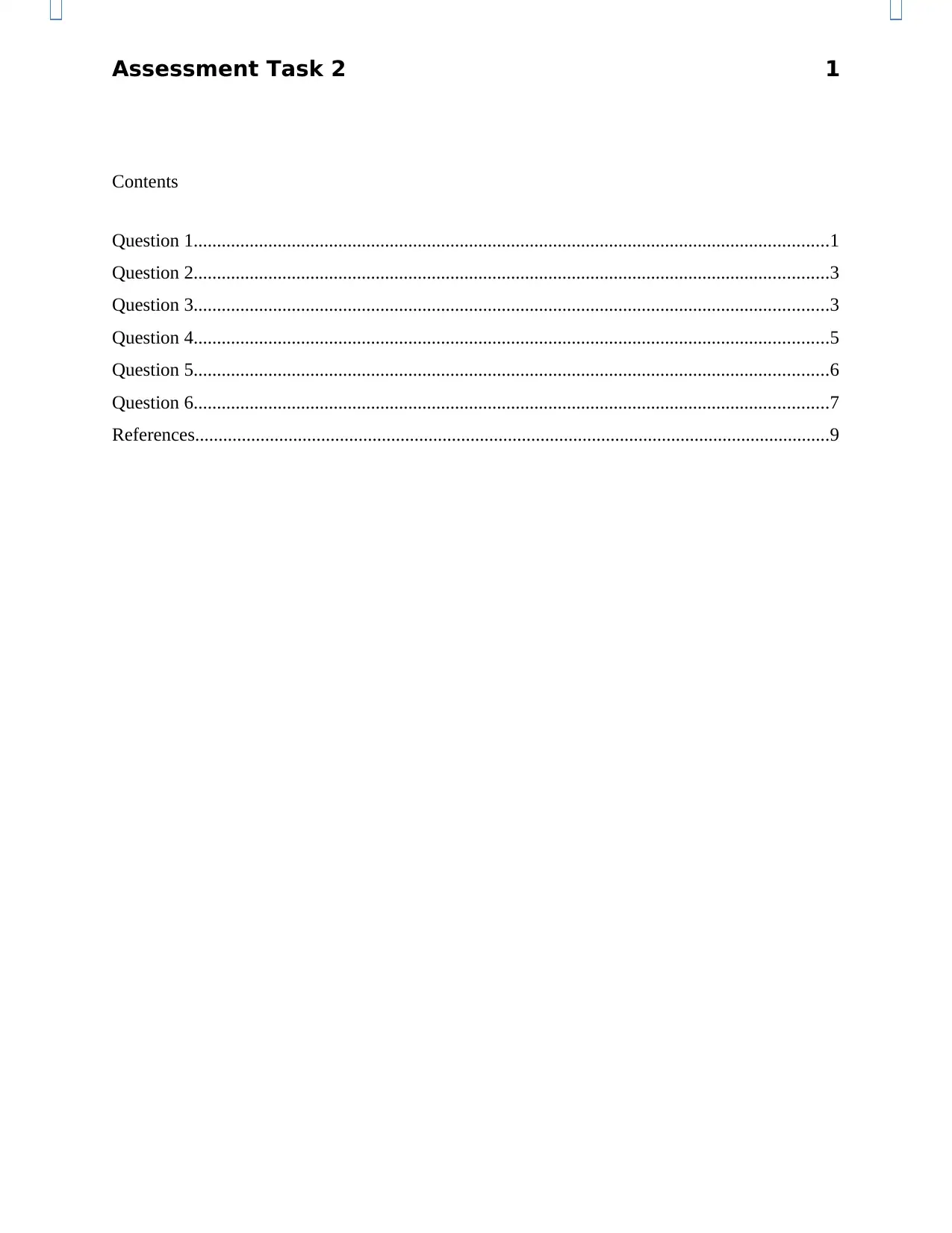
Assessment Task 2 1
Contents
Question 1........................................................................................................................................1
Question 2........................................................................................................................................3
Question 3........................................................................................................................................3
Question 4........................................................................................................................................5
Question 5........................................................................................................................................6
Question 6........................................................................................................................................7
References........................................................................................................................................9
Contents
Question 1........................................................................................................................................1
Question 2........................................................................................................................................3
Question 3........................................................................................................................................3
Question 4........................................................................................................................................5
Question 5........................................................................................................................................6
Question 6........................................................................................................................................7
References........................................................................................................................................9
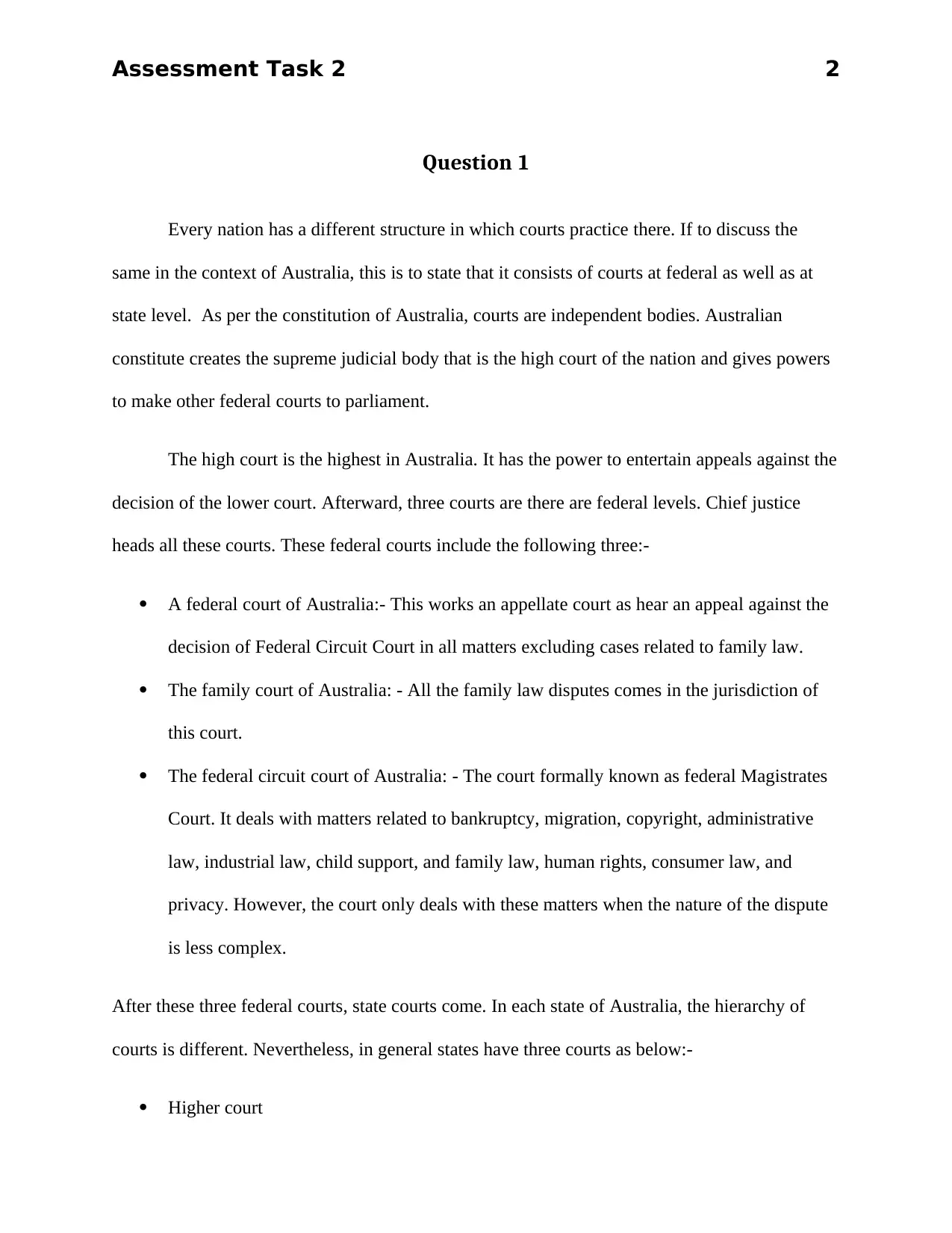
Assessment Task 2 2
Question 1
Every nation has a different structure in which courts practice there. If to discuss the
same in the context of Australia, this is to state that it consists of courts at federal as well as at
state level. As per the constitution of Australia, courts are independent bodies. Australian
constitute creates the supreme judicial body that is the high court of the nation and gives powers
to make other federal courts to parliament.
The high court is the highest in Australia. It has the power to entertain appeals against the
decision of the lower court. Afterward, three courts are there are federal levels. Chief justice
heads all these courts. These federal courts include the following three:-
A federal court of Australia:- This works an appellate court as hear an appeal against the
decision of Federal Circuit Court in all matters excluding cases related to family law.
The family court of Australia: - All the family law disputes comes in the jurisdiction of
this court.
The federal circuit court of Australia: - The court formally known as federal Magistrates
Court. It deals with matters related to bankruptcy, migration, copyright, administrative
law, industrial law, child support, and family law, human rights, consumer law, and
privacy. However, the court only deals with these matters when the nature of the dispute
is less complex.
After these three federal courts, state courts come. In each state of Australia, the hierarchy of
courts is different. Nevertheless, in general states have three courts as below:-
Higher court
Question 1
Every nation has a different structure in which courts practice there. If to discuss the
same in the context of Australia, this is to state that it consists of courts at federal as well as at
state level. As per the constitution of Australia, courts are independent bodies. Australian
constitute creates the supreme judicial body that is the high court of the nation and gives powers
to make other federal courts to parliament.
The high court is the highest in Australia. It has the power to entertain appeals against the
decision of the lower court. Afterward, three courts are there are federal levels. Chief justice
heads all these courts. These federal courts include the following three:-
A federal court of Australia:- This works an appellate court as hear an appeal against the
decision of Federal Circuit Court in all matters excluding cases related to family law.
The family court of Australia: - All the family law disputes comes in the jurisdiction of
this court.
The federal circuit court of Australia: - The court formally known as federal Magistrates
Court. It deals with matters related to bankruptcy, migration, copyright, administrative
law, industrial law, child support, and family law, human rights, consumer law, and
privacy. However, the court only deals with these matters when the nature of the dispute
is less complex.
After these three federal courts, state courts come. In each state of Australia, the hierarchy of
courts is different. Nevertheless, in general states have three courts as below:-
Higher court
⊘ This is a preview!⊘
Do you want full access?
Subscribe today to unlock all pages.

Trusted by 1+ million students worldwide
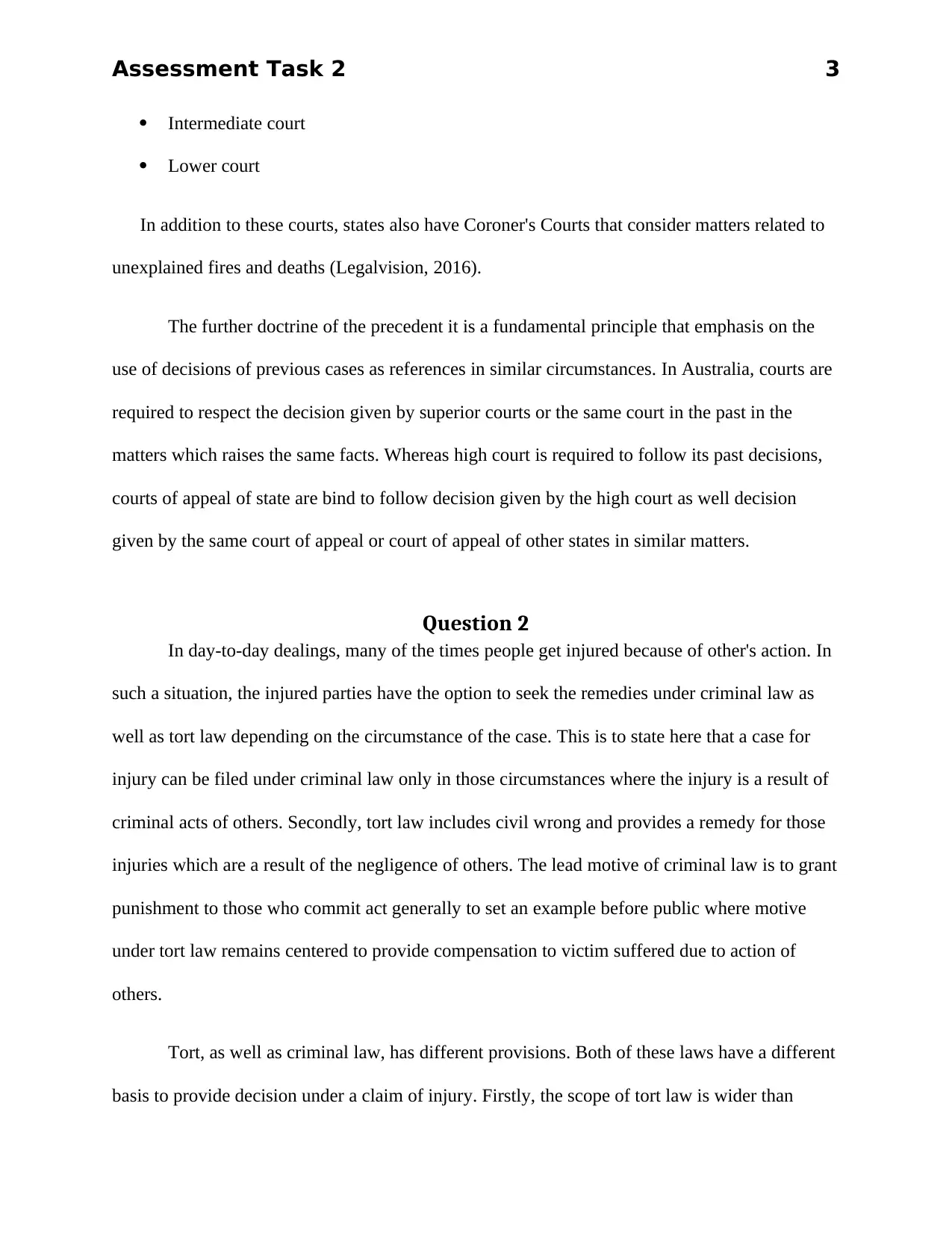
Assessment Task 2 3
Intermediate court
Lower court
In addition to these courts, states also have Coroner's Courts that consider matters related to
unexplained fires and deaths (Legalvision, 2016).
The further doctrine of the precedent it is a fundamental principle that emphasis on the
use of decisions of previous cases as references in similar circumstances. In Australia, courts are
required to respect the decision given by superior courts or the same court in the past in the
matters which raises the same facts. Whereas high court is required to follow its past decisions,
courts of appeal of state are bind to follow decision given by the high court as well decision
given by the same court of appeal or court of appeal of other states in similar matters.
Question 2
In day-to-day dealings, many of the times people get injured because of other's action. In
such a situation, the injured parties have the option to seek the remedies under criminal law as
well as tort law depending on the circumstance of the case. This is to state here that a case for
injury can be filed under criminal law only in those circumstances where the injury is a result of
criminal acts of others. Secondly, tort law includes civil wrong and provides a remedy for those
injuries which are a result of the negligence of others. The lead motive of criminal law is to grant
punishment to those who commit act generally to set an example before public where motive
under tort law remains centered to provide compensation to victim suffered due to action of
others.
Tort, as well as criminal law, has different provisions. Both of these laws have a different
basis to provide decision under a claim of injury. Firstly, the scope of tort law is wider than
Intermediate court
Lower court
In addition to these courts, states also have Coroner's Courts that consider matters related to
unexplained fires and deaths (Legalvision, 2016).
The further doctrine of the precedent it is a fundamental principle that emphasis on the
use of decisions of previous cases as references in similar circumstances. In Australia, courts are
required to respect the decision given by superior courts or the same court in the past in the
matters which raises the same facts. Whereas high court is required to follow its past decisions,
courts of appeal of state are bind to follow decision given by the high court as well decision
given by the same court of appeal or court of appeal of other states in similar matters.
Question 2
In day-to-day dealings, many of the times people get injured because of other's action. In
such a situation, the injured parties have the option to seek the remedies under criminal law as
well as tort law depending on the circumstance of the case. This is to state here that a case for
injury can be filed under criminal law only in those circumstances where the injury is a result of
criminal acts of others. Secondly, tort law includes civil wrong and provides a remedy for those
injuries which are a result of the negligence of others. The lead motive of criminal law is to grant
punishment to those who commit act generally to set an example before public where motive
under tort law remains centered to provide compensation to victim suffered due to action of
others.
Tort, as well as criminal law, has different provisions. Both of these laws have a different
basis to provide decision under a claim of injury. Firstly, the scope of tort law is wider than
Paraphrase This Document
Need a fresh take? Get an instant paraphrase of this document with our AI Paraphraser

Assessment Task 2 4
criminal law in the context of inclusion of injury. Tort law includes intentional as well as
unintentional tort whereas criminal law only includes crime, which is intentional. Secondly,
under criminal law, courts look after the applicable laws and provide remedies to victim party
and punishment to liable parties accordingly. Whereas in a different side, under tort law,
remedies are granted depending on the circumstance of the individual case
(Differencebetween.net, 2019a). Court review every matter, the situation of parties, the loss
occurred to the victim, level of fault of the defendant and then decide remedies for the same. If to
discuss the preference of law for taking an action against defendant for injury, Tort law seems to
be good option due to better remedies available to claimant.
Question 3
Tort law held a person liable for those harms that could be foreseen by a reasonable
person or where a person fails to behave like a reasonable person. In this manner, a reasonable
person has an important role to determine whether the harm was foreseeable or not, whether a
duty of care has been breached in a particular case or not. It is a creation of legal fiction
(Findlaw, 2019a). There are no specific or defined characteristics of a reasonable person and the
test to determine whether the action of a person was of a reasonable person or not is objective
one. In general, a reasonable person can be understood as the one who exercises skills, care, and
judgment in conduct. In other words, a reasonable person can be seen as a justified person. An
average person or a typical person cannot be considered as a reasonable person but if he/she is a
person who behaves in a manner in which a person should behave in the situation that can pose
harm to the public according to standards of the community (Law.jrank.org, 2019). In the
opinion of courts, a reasonable person is the one who pays attention to the situation and risk
criminal law in the context of inclusion of injury. Tort law includes intentional as well as
unintentional tort whereas criminal law only includes crime, which is intentional. Secondly,
under criminal law, courts look after the applicable laws and provide remedies to victim party
and punishment to liable parties accordingly. Whereas in a different side, under tort law,
remedies are granted depending on the circumstance of the individual case
(Differencebetween.net, 2019a). Court review every matter, the situation of parties, the loss
occurred to the victim, level of fault of the defendant and then decide remedies for the same. If to
discuss the preference of law for taking an action against defendant for injury, Tort law seems to
be good option due to better remedies available to claimant.
Question 3
Tort law held a person liable for those harms that could be foreseen by a reasonable
person or where a person fails to behave like a reasonable person. In this manner, a reasonable
person has an important role to determine whether the harm was foreseeable or not, whether a
duty of care has been breached in a particular case or not. It is a creation of legal fiction
(Findlaw, 2019a). There are no specific or defined characteristics of a reasonable person and the
test to determine whether the action of a person was of a reasonable person or not is objective
one. In general, a reasonable person can be understood as the one who exercises skills, care, and
judgment in conduct. In other words, a reasonable person can be seen as a justified person. An
average person or a typical person cannot be considered as a reasonable person but if he/she is a
person who behaves in a manner in which a person should behave in the situation that can pose
harm to the public according to standards of the community (Law.jrank.org, 2019). In the
opinion of courts, a reasonable person is the one who pays attention to the situation and risk
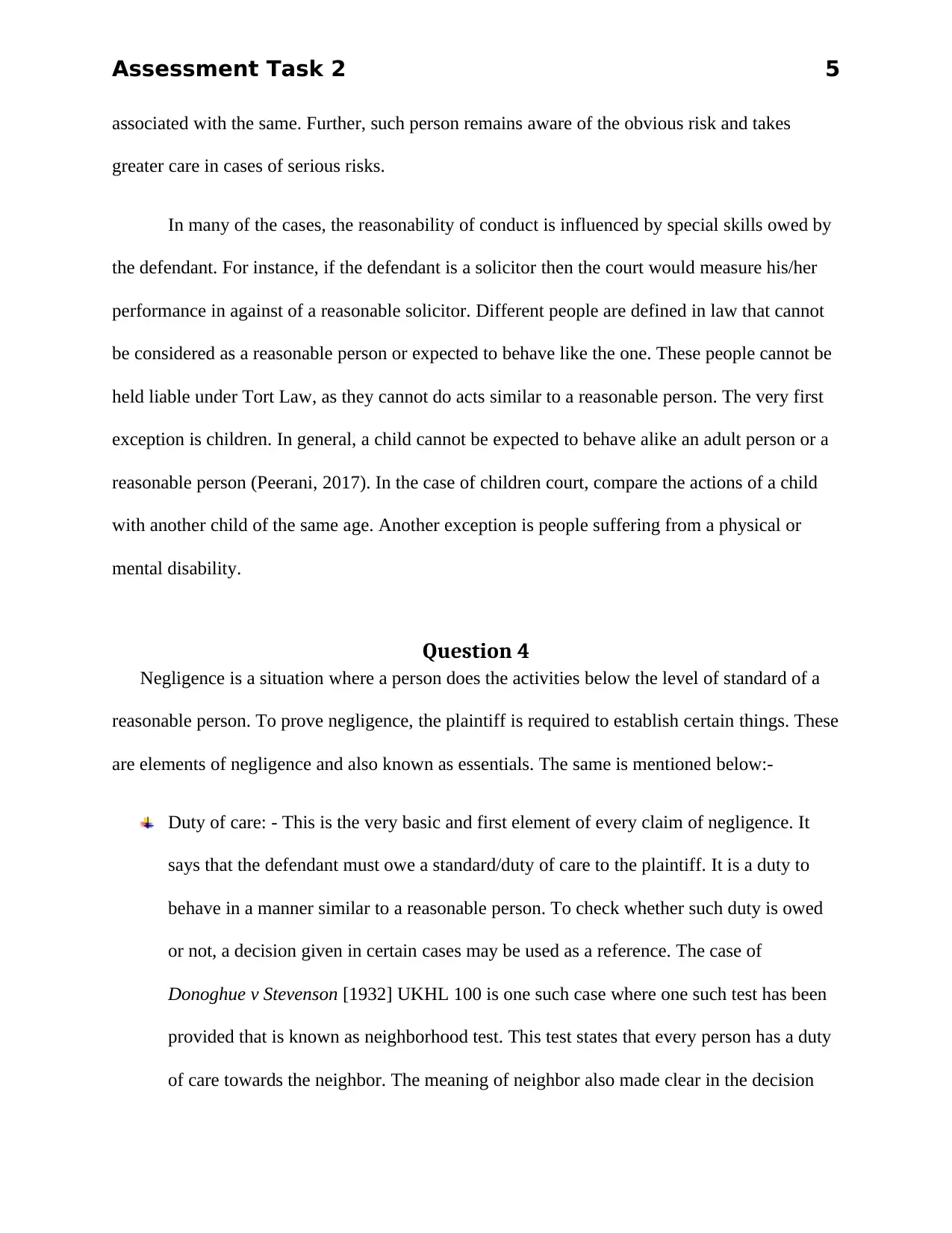
Assessment Task 2 5
associated with the same. Further, such person remains aware of the obvious risk and takes
greater care in cases of serious risks.
In many of the cases, the reasonability of conduct is influenced by special skills owed by
the defendant. For instance, if the defendant is a solicitor then the court would measure his/her
performance in against of a reasonable solicitor. Different people are defined in law that cannot
be considered as a reasonable person or expected to behave like the one. These people cannot be
held liable under Tort Law, as they cannot do acts similar to a reasonable person. The very first
exception is children. In general, a child cannot be expected to behave alike an adult person or a
reasonable person (Peerani, 2017). In the case of children court, compare the actions of a child
with another child of the same age. Another exception is people suffering from a physical or
mental disability.
Question 4
Negligence is a situation where a person does the activities below the level of standard of a
reasonable person. To prove negligence, the plaintiff is required to establish certain things. These
are elements of negligence and also known as essentials. The same is mentioned below:-
Duty of care: - This is the very basic and first element of every claim of negligence. It
says that the defendant must owe a standard/duty of care to the plaintiff. It is a duty to
behave in a manner similar to a reasonable person. To check whether such duty is owed
or not, a decision given in certain cases may be used as a reference. The case of
Donoghue v Stevenson [1932] UKHL 100 is one such case where one such test has been
provided that is known as neighborhood test. This test states that every person has a duty
of care towards the neighbor. The meaning of neighbor also made clear in the decision
associated with the same. Further, such person remains aware of the obvious risk and takes
greater care in cases of serious risks.
In many of the cases, the reasonability of conduct is influenced by special skills owed by
the defendant. For instance, if the defendant is a solicitor then the court would measure his/her
performance in against of a reasonable solicitor. Different people are defined in law that cannot
be considered as a reasonable person or expected to behave like the one. These people cannot be
held liable under Tort Law, as they cannot do acts similar to a reasonable person. The very first
exception is children. In general, a child cannot be expected to behave alike an adult person or a
reasonable person (Peerani, 2017). In the case of children court, compare the actions of a child
with another child of the same age. Another exception is people suffering from a physical or
mental disability.
Question 4
Negligence is a situation where a person does the activities below the level of standard of a
reasonable person. To prove negligence, the plaintiff is required to establish certain things. These
are elements of negligence and also known as essentials. The same is mentioned below:-
Duty of care: - This is the very basic and first element of every claim of negligence. It
says that the defendant must owe a standard/duty of care to the plaintiff. It is a duty to
behave in a manner similar to a reasonable person. To check whether such duty is owed
or not, a decision given in certain cases may be used as a reference. The case of
Donoghue v Stevenson [1932] UKHL 100 is one such case where one such test has been
provided that is known as neighborhood test. This test states that every person has a duty
of care towards the neighbor. The meaning of neighbor also made clear in the decision
⊘ This is a preview!⊘
Do you want full access?
Subscribe today to unlock all pages.

Trusted by 1+ million students worldwide

Assessment Task 2 6
where it was provided that every person who is directly affected by the defendant's action
is considered as a neighbor to him/her (E-lawresources.co.uk, 2019).
Breach - After the establishment of a duty of care, another requirement states that such
duty must be breached. It means the defendant must fail to conduct the activities in a
manner similar to a reasonable person and must avoid such standard/duty (Lindh, Pooler,
Tamparo, Dahl, & Morris, 2009).
Harm - As per the requirement of the third element of negligence, some harm must be
done to the plaintiff. Unless there is no harm happened to him/her, there would be a
reason to initiate a claim against the defendant. Negligence identifies three types of harms
namely pure economic harm, physical damage, and mental injuries. It means out of these
three, a plaintiff is required to be suffered from one or more.
Reason of harm: - The fourth and last element of a successful claim of negligence states
that there must be a direct relationship between loss or injury happened to plaintiff and
negligence of the defendant. Hence, to say that only occurrence of harm is not enough but
the reason of this harm is required to be a negligent action of the defendant.
Question 5
There are many business laws, which deals with property and in the commercial world,
people often use these terms. Therefore, the same is required to understand in detail. Mainly two
types of properties are there which are going to discuss further and these are personal property
and real property. Provisions related to these two kinds of properties are mentioned under
different laws. Starting the discussion from the personal property this is to state that the same is
refers to movable property (Corporate.findlaw.com, 2019). Except for land, anything can be
where it was provided that every person who is directly affected by the defendant's action
is considered as a neighbor to him/her (E-lawresources.co.uk, 2019).
Breach - After the establishment of a duty of care, another requirement states that such
duty must be breached. It means the defendant must fail to conduct the activities in a
manner similar to a reasonable person and must avoid such standard/duty (Lindh, Pooler,
Tamparo, Dahl, & Morris, 2009).
Harm - As per the requirement of the third element of negligence, some harm must be
done to the plaintiff. Unless there is no harm happened to him/her, there would be a
reason to initiate a claim against the defendant. Negligence identifies three types of harms
namely pure economic harm, physical damage, and mental injuries. It means out of these
three, a plaintiff is required to be suffered from one or more.
Reason of harm: - The fourth and last element of a successful claim of negligence states
that there must be a direct relationship between loss or injury happened to plaintiff and
negligence of the defendant. Hence, to say that only occurrence of harm is not enough but
the reason of this harm is required to be a negligent action of the defendant.
Question 5
There are many business laws, which deals with property and in the commercial world,
people often use these terms. Therefore, the same is required to understand in detail. Mainly two
types of properties are there which are going to discuss further and these are personal property
and real property. Provisions related to these two kinds of properties are mentioned under
different laws. Starting the discussion from the personal property this is to state that the same is
refers to movable property (Corporate.findlaw.com, 2019). Except for land, anything can be
Paraphrase This Document
Need a fresh take? Get an instant paraphrase of this document with our AI Paraphraser
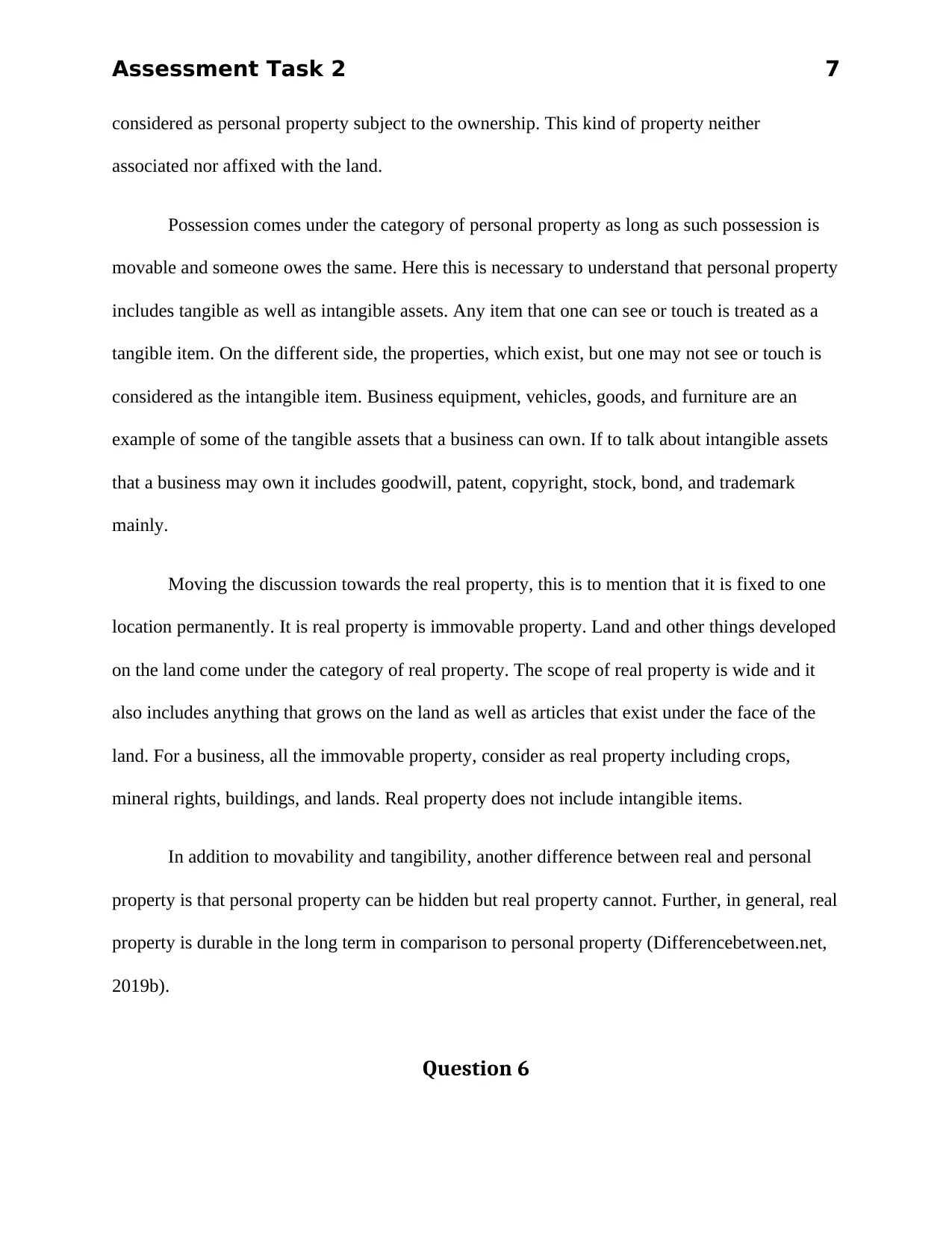
Assessment Task 2 7
considered as personal property subject to the ownership. This kind of property neither
associated nor affixed with the land.
Possession comes under the category of personal property as long as such possession is
movable and someone owes the same. Here this is necessary to understand that personal property
includes tangible as well as intangible assets. Any item that one can see or touch is treated as a
tangible item. On the different side, the properties, which exist, but one may not see or touch is
considered as the intangible item. Business equipment, vehicles, goods, and furniture are an
example of some of the tangible assets that a business can own. If to talk about intangible assets
that a business may own it includes goodwill, patent, copyright, stock, bond, and trademark
mainly.
Moving the discussion towards the real property, this is to mention that it is fixed to one
location permanently. It is real property is immovable property. Land and other things developed
on the land come under the category of real property. The scope of real property is wide and it
also includes anything that grows on the land as well as articles that exist under the face of the
land. For a business, all the immovable property, consider as real property including crops,
mineral rights, buildings, and lands. Real property does not include intangible items.
In addition to movability and tangibility, another difference between real and personal
property is that personal property can be hidden but real property cannot. Further, in general, real
property is durable in the long term in comparison to personal property (Differencebetween.net,
2019b).
Question 6
considered as personal property subject to the ownership. This kind of property neither
associated nor affixed with the land.
Possession comes under the category of personal property as long as such possession is
movable and someone owes the same. Here this is necessary to understand that personal property
includes tangible as well as intangible assets. Any item that one can see or touch is treated as a
tangible item. On the different side, the properties, which exist, but one may not see or touch is
considered as the intangible item. Business equipment, vehicles, goods, and furniture are an
example of some of the tangible assets that a business can own. If to talk about intangible assets
that a business may own it includes goodwill, patent, copyright, stock, bond, and trademark
mainly.
Moving the discussion towards the real property, this is to mention that it is fixed to one
location permanently. It is real property is immovable property. Land and other things developed
on the land come under the category of real property. The scope of real property is wide and it
also includes anything that grows on the land as well as articles that exist under the face of the
land. For a business, all the immovable property, consider as real property including crops,
mineral rights, buildings, and lands. Real property does not include intangible items.
In addition to movability and tangibility, another difference between real and personal
property is that personal property can be hidden but real property cannot. Further, in general, real
property is durable in the long term in comparison to personal property (Differencebetween.net,
2019b).
Question 6
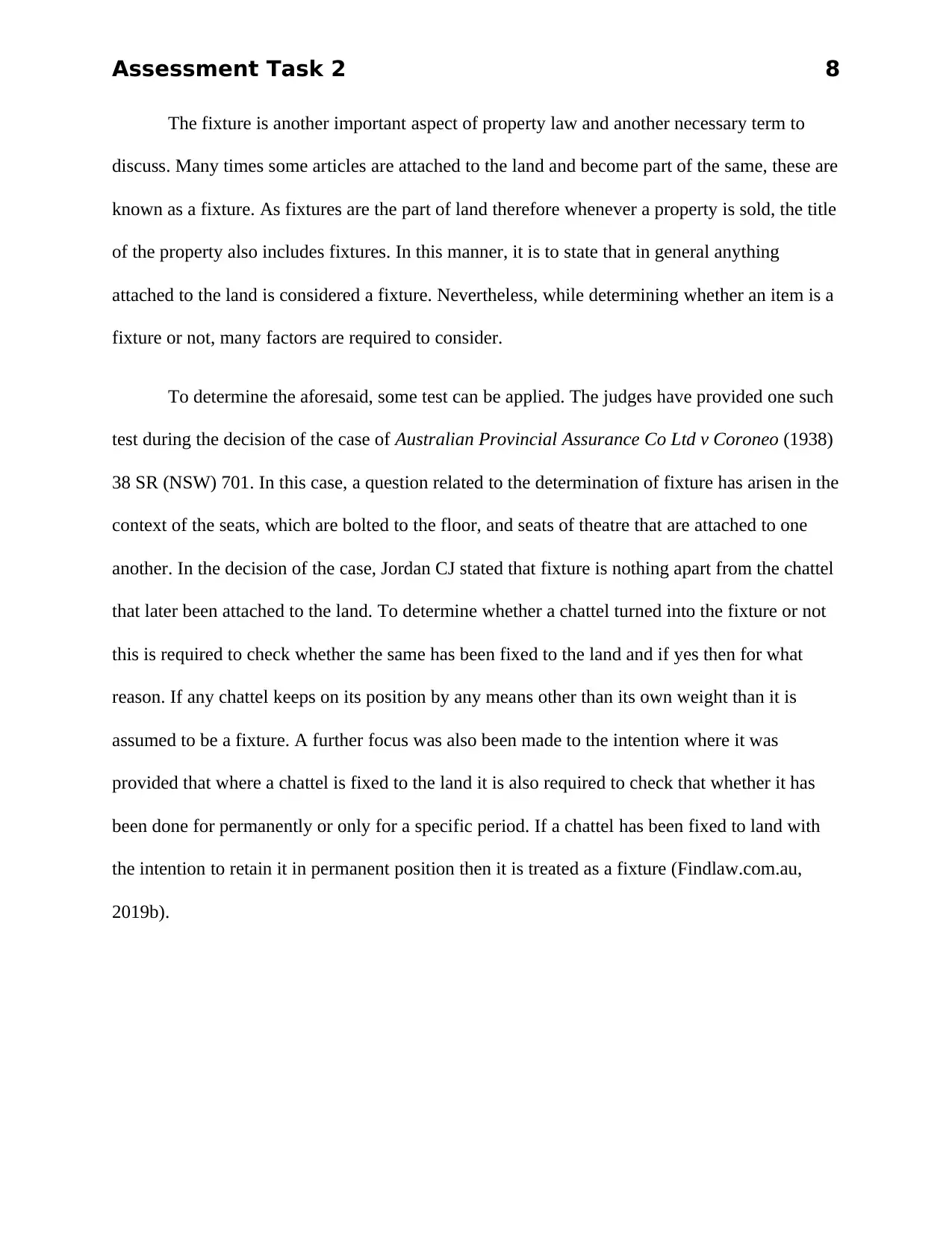
Assessment Task 2 8
The fixture is another important aspect of property law and another necessary term to
discuss. Many times some articles are attached to the land and become part of the same, these are
known as a fixture. As fixtures are the part of land therefore whenever a property is sold, the title
of the property also includes fixtures. In this manner, it is to state that in general anything
attached to the land is considered a fixture. Nevertheless, while determining whether an item is a
fixture or not, many factors are required to consider.
To determine the aforesaid, some test can be applied. The judges have provided one such
test during the decision of the case of Australian Provincial Assurance Co Ltd v Coroneo (1938)
38 SR (NSW) 701. In this case, a question related to the determination of fixture has arisen in the
context of the seats, which are bolted to the floor, and seats of theatre that are attached to one
another. In the decision of the case, Jordan CJ stated that fixture is nothing apart from the chattel
that later been attached to the land. To determine whether a chattel turned into the fixture or not
this is required to check whether the same has been fixed to the land and if yes then for what
reason. If any chattel keeps on its position by any means other than its own weight than it is
assumed to be a fixture. A further focus was also been made to the intention where it was
provided that where a chattel is fixed to the land it is also required to check that whether it has
been done for permanently or only for a specific period. If a chattel has been fixed to land with
the intention to retain it in permanent position then it is treated as a fixture (Findlaw.com.au,
2019b).
The fixture is another important aspect of property law and another necessary term to
discuss. Many times some articles are attached to the land and become part of the same, these are
known as a fixture. As fixtures are the part of land therefore whenever a property is sold, the title
of the property also includes fixtures. In this manner, it is to state that in general anything
attached to the land is considered a fixture. Nevertheless, while determining whether an item is a
fixture or not, many factors are required to consider.
To determine the aforesaid, some test can be applied. The judges have provided one such
test during the decision of the case of Australian Provincial Assurance Co Ltd v Coroneo (1938)
38 SR (NSW) 701. In this case, a question related to the determination of fixture has arisen in the
context of the seats, which are bolted to the floor, and seats of theatre that are attached to one
another. In the decision of the case, Jordan CJ stated that fixture is nothing apart from the chattel
that later been attached to the land. To determine whether a chattel turned into the fixture or not
this is required to check whether the same has been fixed to the land and if yes then for what
reason. If any chattel keeps on its position by any means other than its own weight than it is
assumed to be a fixture. A further focus was also been made to the intention where it was
provided that where a chattel is fixed to the land it is also required to check that whether it has
been done for permanently or only for a specific period. If a chattel has been fixed to land with
the intention to retain it in permanent position then it is treated as a fixture (Findlaw.com.au,
2019b).
⊘ This is a preview!⊘
Do you want full access?
Subscribe today to unlock all pages.

Trusted by 1+ million students worldwide

Assessment Task 2 9
References
Australian Provincial Assurance Co Ltd v Coroneo (1938) 38 SR (NSW) 701
Corporate.findlaw.com. (2019). Personal Property. Retrieved from:
https://corporate.findlaw.com/business-operations/property/personal-property.html
Differencebetween.net. (2019a). Difference Between Tort and Crime. Retrieved from:
http://www.differencebetween.net/miscellaneous/legal-miscellaneous/difference-
between-tort-and-crime/
Differencebetween.net. (2019b). Differences between Personal Property and Real Property.
Retrieved from: http://www.differencebetween.net/business/differences-between-
personal-property-and-real-property/
Donoghue v Stevenson [1932] UKHL 100
E-lawresources.co.uk. (2019). Negligence - duty of care. Retrieved from: http://www.e-
lawresources.co.uk/Duty-of-care.php
Findlaw. (2019a). Negligence and the 'Reasonable Person'. Retrieved from:
https://injury.findlaw.com/accident-injury-law/standards-of-care-and-the-reasonable-
person.html
Findlaw.com.au. (2019b). Property law: What is the difference between a fixture and a chattel?
Retrieved from: https://www.findlaw.com.au/articles/4520/property-law-what-is-the-
difference-between-a-fixt.aspx
References
Australian Provincial Assurance Co Ltd v Coroneo (1938) 38 SR (NSW) 701
Corporate.findlaw.com. (2019). Personal Property. Retrieved from:
https://corporate.findlaw.com/business-operations/property/personal-property.html
Differencebetween.net. (2019a). Difference Between Tort and Crime. Retrieved from:
http://www.differencebetween.net/miscellaneous/legal-miscellaneous/difference-
between-tort-and-crime/
Differencebetween.net. (2019b). Differences between Personal Property and Real Property.
Retrieved from: http://www.differencebetween.net/business/differences-between-
personal-property-and-real-property/
Donoghue v Stevenson [1932] UKHL 100
E-lawresources.co.uk. (2019). Negligence - duty of care. Retrieved from: http://www.e-
lawresources.co.uk/Duty-of-care.php
Findlaw. (2019a). Negligence and the 'Reasonable Person'. Retrieved from:
https://injury.findlaw.com/accident-injury-law/standards-of-care-and-the-reasonable-
person.html
Findlaw.com.au. (2019b). Property law: What is the difference between a fixture and a chattel?
Retrieved from: https://www.findlaw.com.au/articles/4520/property-law-what-is-the-
difference-between-a-fixt.aspx
Paraphrase This Document
Need a fresh take? Get an instant paraphrase of this document with our AI Paraphraser
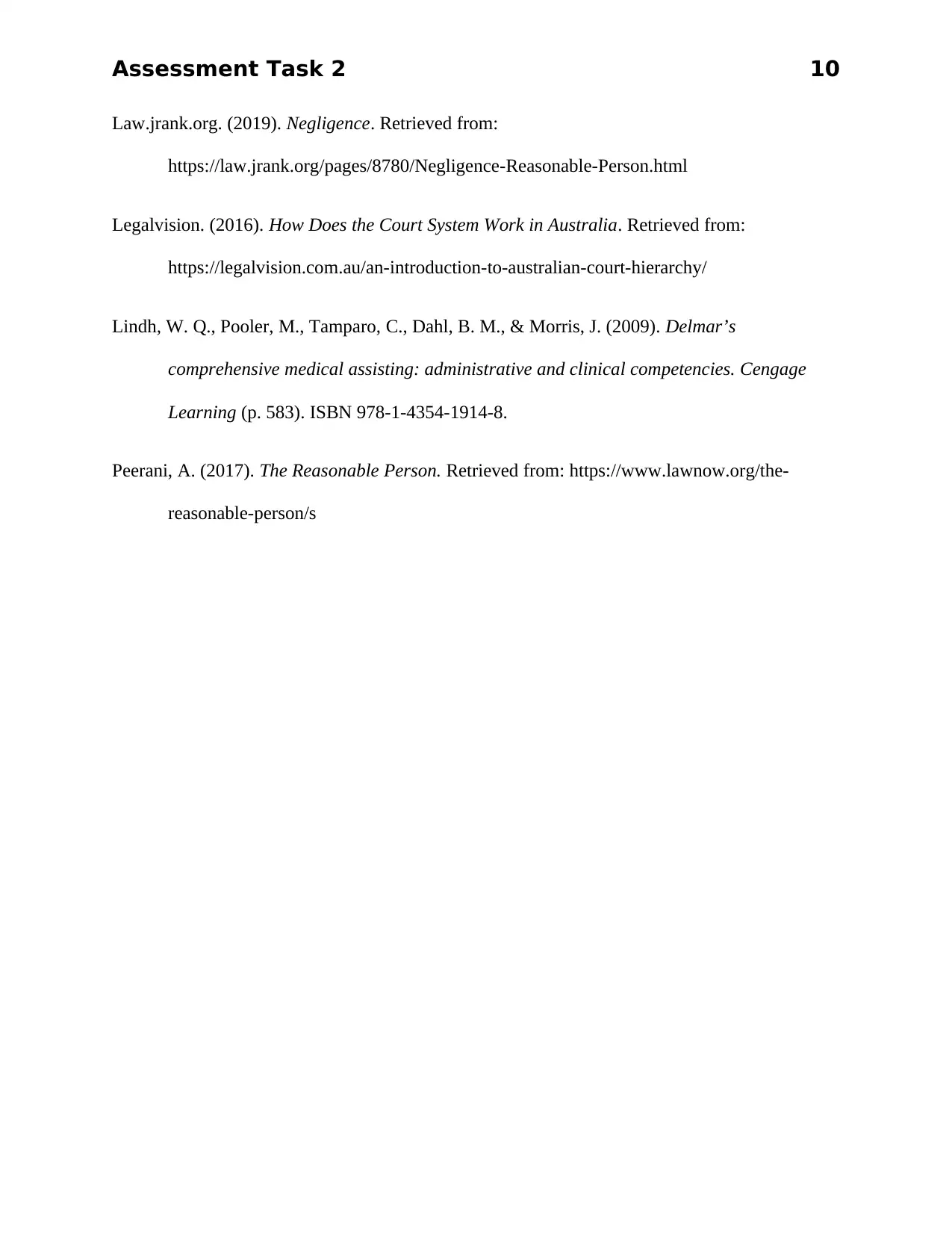
Assessment Task 2 10
Law.jrank.org. (2019). Negligence. Retrieved from:
https://law.jrank.org/pages/8780/Negligence-Reasonable-Person.html
Legalvision. (2016). How Does the Court System Work in Australia. Retrieved from:
https://legalvision.com.au/an-introduction-to-australian-court-hierarchy/
Lindh, W. Q., Pooler, M., Tamparo, C., Dahl, B. M., & Morris, J. (2009). Delmar’s
comprehensive medical assisting: administrative and clinical competencies. Cengage
Learning (p. 583). ISBN 978-1-4354-1914-8.
Peerani, A. (2017). The Reasonable Person. Retrieved from: https://www.lawnow.org/the-
reasonable-person/s
Law.jrank.org. (2019). Negligence. Retrieved from:
https://law.jrank.org/pages/8780/Negligence-Reasonable-Person.html
Legalvision. (2016). How Does the Court System Work in Australia. Retrieved from:
https://legalvision.com.au/an-introduction-to-australian-court-hierarchy/
Lindh, W. Q., Pooler, M., Tamparo, C., Dahl, B. M., & Morris, J. (2009). Delmar’s
comprehensive medical assisting: administrative and clinical competencies. Cengage
Learning (p. 583). ISBN 978-1-4354-1914-8.
Peerani, A. (2017). The Reasonable Person. Retrieved from: https://www.lawnow.org/the-
reasonable-person/s
1 out of 11
Related Documents
Your All-in-One AI-Powered Toolkit for Academic Success.
+13062052269
info@desklib.com
Available 24*7 on WhatsApp / Email
![[object Object]](/_next/static/media/star-bottom.7253800d.svg)
Unlock your academic potential
Copyright © 2020–2025 A2Z Services. All Rights Reserved. Developed and managed by ZUCOL.




